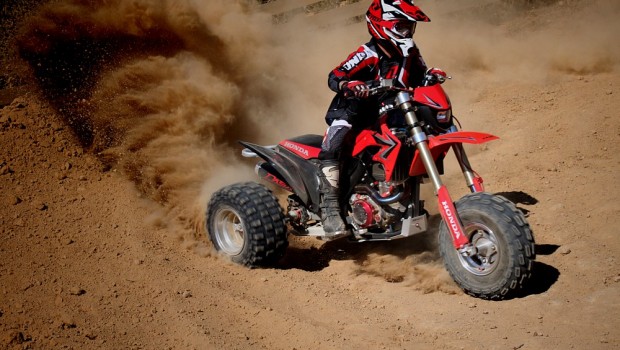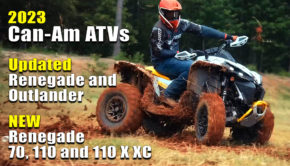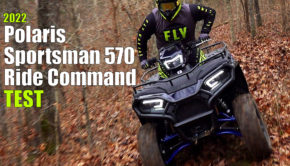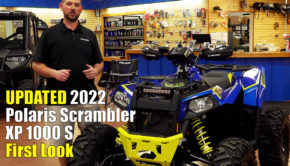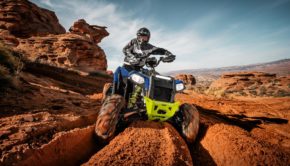TPC 450 Hybrid Three-Wheeler Test
From do it yourself kits to full-on conversions, TPC does what major ATV manufacturers won’t dare do!
Story and images by: Joe Tolle
TPC Trikes, out of Vestal, New York, is a company founded out of necessity. Like many die-hard three-wheeler enthusiasts from back in the day, company owner, Bill Casey, wasn’t interested in abandoning his trikes and switching to four-wheelers simply because the CPSC pressured the manufacturers into abandoning their production.
Casey continued racing his Honda ATCs from the time the sport fizzled out in the late 80s, until its modern day resurgence as vintage ATV racing. Faced with aging equipment and parts becoming more difficult to find, he decided to build a three-wheeler with modern day technology, in addition to readily available replacement and performance parts. To make this happen, Bill did what so many other ATV performance shops have done in order to achieve the highest possible level of performance; he built a hybrid.

Faced with aging equipment and parts becoming more difficult to find, Casey decided to build a three-wheeler with modern day technology, in addition to readily available replacement and performance parts.
Since completing his first hybrid in 2008 TPC Trikes has won a number of races and championships. Fred Morrell won the 2011 CRA Motocross Championship. Former Team Kawasaki sensation Jackie Meadows came out of retirement to win the three-wheeler Open A class at the 2012 Pine Lake Extreme Dirt Track National. Most recently, Shad Spencer won the Open Expert Motocross Class at Trikefest 2013, beating out a stacked field of modern day three-wheeler racers, most of which were piloting hybrids of one sort or another.
How It’s Done

TPC constructs a new frame section that replaces almost the entire upper main frame, in addition to the lower frame rails from the front of the engine forward.
While TPC has converted other ATVs and dirt bikes into three-wheelers, their most popular conversion is the Honda TRX450R. To convert the 450R into a three-wheeler, TPC constructs a new frame section that replaces almost the entire upper main frame, in addition to the lower frame rails from the front of the engine forward. TPC also produces triple clamps that work with 2002-2008 CRF Showa inverted forks. Their front hub and axle are designed to work with a 3+2 offset front wheel, which is what the 450R is equipped with stock.
Along with having a 2006 or newer TRX450R to convert, you’ll also need a 2005-2008 CR450F dirt bike gas tank, radiator, radiator shrouds, fork, and front brake system. You’ll also need a CRF complete head assembly and FCR carburetor. The carburetor and head are shorter than the ones found on the ATV, which allows for a lower tank and seat height for a lower center of gravity. Accompanied by a good aftermarket exhaust, the CRF head upgrade will also yield around 10 more horsepower than the stock TRX motor.

TPC also produces triple clamps that work with 2002-2008 CRF Show’s inverted forks. Their front hub and axle are designed to work with a 3+2 offset front wheel, which is what the 450R is equipped with stock.
The building process can be handled several ways. Those who want to assemble their own machine will need to send their ATV frame to TPC for conversion. TPC will convert the frame and ship it back to you raw with their triple clamps and front hub for $2600. Frame powder coating is additional.You can take your ATV to TPC and they’ll convert the frame and build the machine with all the necessary dirt bike parts for $5500. If you are interested in purchasing a turnkey machine, TPC will build one from scratch using all stock components for $8500. TPC also works closely with aftermarket companies like Lone Star Racing, Elka, and Dasa, allowing them to build turnkey race machines with the same trick components being used by today’s top four-wheeled ATV racers. Whatever your budget, skies the limit!
Hitching a Ride
After begging TPC for a ride on one of their machines, they happily volunteered customer Ryan Cogswell’s super trick and clean freeride machine for ATV on Demand test rider, Rob Ray, to thrash on. We met up with TPC’s Bill Casey and Ryan Cogswell at Trikefest last year, where Ryan also had his recently acquired TPC motocross machine on hand for us to drool over.
Built to Freeride

The TPC converted frame looks far more rigid and overbuilt than the stock 450R frame, not to mention any vintage three-wheeler frame
Ryan and representatives from several companies assembled the red TPC, which is like looking at a catalog of off road performance parts and eye candy. Of course, it all begins with the TPC conversion. The TPC converted frame looks far more rigid and overbuilt than the stock 450R frame, not to mention any vintage three-wheeler frame. The oversized upper frame rails, rectangular neck which runs up to the head tube and steering stem, plus a large diameter, single square tube which runs down and ties into the lower frame rails, creates a chassis that looks 21st century. Finishing the frame’s transformation was a fresh powder coating by Matt Rabideau from XXX Powder Coating.Looking the machine over, all of the components seemed to blend together like a production machine, with tight lines and no glaring, uneven gaps. We were impressed.

A +2 inch Lone Star Racing swingarm and LSR Axcaliber racing axle add length and width to the machine,
A +2 inch Lone Star Racing swingarm and LSR Axcaliber racing axle add length and width to the machine, improving stability while enhancing strength. The swingarm is equipped with LSR’s billet aluminum axle carrier and G-Force billet hubs were installed at the ends of the axle. From the dirt bike world, an Applied Racing billet steering stem and Pro Taper bar clamps were used to round out the chassis setup.
Complementing the CR450F dirt bike forks, an Elka Stage 3 shock and long-travel linkage were utilized from the ATV world. The dual-stage Elka shock features high and low-speed compression and rebound damping, in addition to ride height adjustment.

Dustin Bushey, from Rigid Performance, did some mild porting and valve work, in addition to installing a 13.5:1 compression piston
To take full advantage of the additional performance provided by the CRF head and cams, Dustin Bushey, from Rigid Performance, did some mild porting and valve work, in addition to installing a 13.5:1 compression piston and an R&D Power Bowl in the carburetor. To help the engine breath, a K&N power lid and filter increased intake velocity, while a very proven, full DASA racing exhaust allows spent fuel to escape uninhibited. As configured, we’d expect this engine to easily produce over 50HP.
To keep the engine running cool, a Blackworks, high-capacity, polished radiator was installed with Evotech radiator braces, in addition to a Boyseen Supercooler water pump cover and impeller.Other goodies include a Trinity clutch cover and Yoshimura engine plug kit. Power is transferred to the rear axle via a Regina z-ring Gold Series chain and Ironman sprockets.
Power is put to the ground by 20-inch Maxxis I Razr tires out back. A 21-inch Kenda Viper front tire handles directional control.The tires are wrapped around sharp looking AMS aluminum wheels.

Tag T-2 bars are strong and help dampen vibration. ASV unbreakable levers add style and survivability to the controls, which will undoubtedly face a rollover at some point
The machine’s contact points bristle with quality.Tag T-2 bars are strong and help dampen vibration. ASV unbreakable levers add style and survivability to the controls, which will undoubtedly face a rollover at some point. A pair of Blingstar Notorious pegs offer a wide stable platform on which to rest your feet.A Pro Armor rear brake pedal and shifter provide a solid, rigid feeling through your riding boots and add even more style to the machine. Wave rotors replaced the stock brake rotors at both ends.
PRM skid plates provide protection from beneath. A Pro Armor Pro Race rear grab bar offers a wide gripping area, which makes keeping the machine balanced easier when lifting. To finish off the looks of the machine, custom graphics were designed by owner, Ryan Cogswell, who is a professional tattoo artist and owns several shops.Daniel’s Signs printed Ryan’s graphic design.
Ride Time
 Stepping aboard Ryan’s TPC, you instantly realize what a quarter century of ergonomic refinements has done for ATVs and dirt bikes. The machine feels narrow and easy to grip with your knees. The flat narrow seat provides uninhibited movement from front to back. TPC’s bar clamp placement seems ideally located, as the bar placement feels perfectly matched to the machine’s modern feel. Just sitting on the TPC makes you eager to ride!
Stepping aboard Ryan’s TPC, you instantly realize what a quarter century of ergonomic refinements has done for ATVs and dirt bikes. The machine feels narrow and easy to grip with your knees. The flat narrow seat provides uninhibited movement from front to back. TPC’s bar clamp placement seems ideally located, as the bar placement feels perfectly matched to the machine’s modern feel. Just sitting on the TPC makes you eager to ride!
The engine fires to life with a sound and responsiveness to a crack of the throttle that lets you know this thing will munch any vintage thumper in a straight line. The motor emitted a very familiar, hopped-up Honda 450R feel. Rob felt that the built TRX engine delivered nearly the perfect blend of instantly available power at all RPMs, combined with the fast revving, almost two-stroke like, throttle response. The quick revving nature of the modern four-stroke lets you get the rear wheels spinning for slides on demand, with virtually no need to touch the clutch.

The quick revving nature of the modern four-stroke lets you get the rear wheels spinning for slides on demand, with virtually no need to touch the clutch.
While going fast and spinning the tires is no problem, without the “light switch” type power delivery of a two-stroke, the TPC seemed less fatiguing to ride. Times were you needed traction like holeshots, short runs at jumps exiting turns, and slippery hillsides, yet the modern four-stroke is still pretty rideable and controllable. For all the same reasons the modern four stroke engines work well in quads, they seem to work brilliantly in a hybrid three-wheeler.
 Steering on the TPC is very light, even at slow speeds. It’s also very responsive; we suspect, in part, due to its head angle, which is notably steeper than what you would find on a vintage 250R.Its light, agile steering worked extremely well on tight sections of the track, but kept us on our toes at higher speeds, as it felt just a bit nervous.The ride was impressively stable for a three-wheeler, especially considering that you don’t sit as uncomfortably low as you do on most vintage trikes. The responsive steering worked well on Haspin Acres’ wooded trails; however, TPCs don’t have as tight a turning radius as vintage machines like the Honda 250R or 350. TPC tells us that their chassis was, “…developed for motocross racing.” So, while you can trail ride them, they are at home on the track.
Steering on the TPC is very light, even at slow speeds. It’s also very responsive; we suspect, in part, due to its head angle, which is notably steeper than what you would find on a vintage 250R.Its light, agile steering worked extremely well on tight sections of the track, but kept us on our toes at higher speeds, as it felt just a bit nervous.The ride was impressively stable for a three-wheeler, especially considering that you don’t sit as uncomfortably low as you do on most vintage trikes. The responsive steering worked well on Haspin Acres’ wooded trails; however, TPCs don’t have as tight a turning radius as vintage machines like the Honda 250R or 350. TPC tells us that their chassis was, “…developed for motocross racing.” So, while you can trail ride them, they are at home on the track.
At the point we rode this machine, Ryan had not yet finalized his suspension’s internal settings. The fork seemed a bit too stiff, while the rear shock was far too soft for aggressive moto work. Still, with so much travel, Rob cranked the Elka rear shock’s compression to the max and let it rip off a few jumps. Despite some notable imbalance in the suspension’s action on the ground, the machine’s weight feels well balanced in the air flying level off jumps. Lifting the front wheel for trail obstacles was easy, but required a bit more body English than on most vintage trikes, thanks to its stretched-out wheelbase. You can tell that the TPC is a bit heavier than a vintage two-stroke, but with the smoother engine, a bit of extra weight was almost a non-issue.

Despite some notable imbalance in the suspension’s action on the ground, the machine’s weight feels well balanced in the air
After our test, Shawn Nut of Liquid Reaction went through and revalved and resprung the forks and Elka shock to provide a, “…well-balanced ride and much better all around performance,” according to Ryan Cogswell. Feeling around the limits of the incomplete suspension, we were enthusiastic about the handling of the TPC. However, we feel a ride on one with fully dialed in suspension is necessary before we can give it two thumbs up.
Conclusion
 Owning a modern day high-performance three-wheeler isn’t as easy as running down to your local Honda shop and buying a new machine. However, ATV Racers have always been all about building hybrids in search of ultimate performance. We were impressed with the overall construction of the machine. The ride was nearly as impressive, despite the unrefined suspension settings. Beating out a field of mostly hybrid machines at Trikefest this year, Shadd Spencer proved the performance capability of the TPC in a field of modern machines.Rob’s ride was enough to get him all excited about the prospect of building one for himself.
Owning a modern day high-performance three-wheeler isn’t as easy as running down to your local Honda shop and buying a new machine. However, ATV Racers have always been all about building hybrids in search of ultimate performance. We were impressed with the overall construction of the machine. The ride was nearly as impressive, despite the unrefined suspension settings. Beating out a field of mostly hybrid machines at Trikefest this year, Shadd Spencer proved the performance capability of the TPC in a field of modern machines.Rob’s ride was enough to get him all excited about the prospect of building one for himself.
Contact TPC Trikes: www.tpctrikes.com

